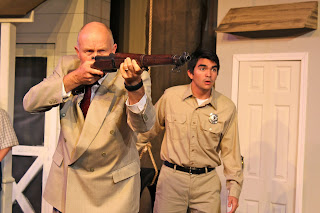It can’t be easy for a Southern California college student to play Scout Finch, a child living in the racial turmoil of Alabama in the 1930s, yet freshman Julie Ploehn succeeds with flying colors. In fact, the entirety of the cast was able to create believable characters with Southern twangs, not a hint of the collegiate vibe to be found.
Biola University’s To Kill A Mockingbird, directed by associate theater professor Forrest Robinson is an intense drama performed with passion and well-timed flow. The actors truly made the play enjoyable. The three main characters—Scout (Phlehn), Dill (Atticus Shires) and Jem (Cris Cockrell)—are young children and the college freshmen created childlike personas with seeming ease. They were not childish, but rather captured the heart of a child in their facial expressions, the way they moved around the stage and the way in which their dialogue was spoken, all while using very believable Southern accents. “I tell my students the technique of developing the characters… I like them to discover [the characters] on their own,” Robinson said. “I’m trying to lead them where I would like them to go.”
The entire play takes place on one set: three houses, a tire swing and a fence. In a small black box setting, it was easier to focus on the storyline and the actors without being distracted by stagehands moving sets back and forth. It also made the flow of the play move with near perfection. With the exception of intermission there were no breaks in between scenes. Each segment flowed right into the next as naturally as if one was reading the book, demanding the viewer’s attention with every line. Robinson did an excellent job of appropriately mixing comical relief in with an otherwise extremely intense show.
The entire play was carried out with professional ease. Sound effects, acting, lighting and set design created a world the audience was drawn into. Watching Atticus Finch fight for the right of a condemned black man in the courthouse left palpable suspense in the air. The chemistry of the lead characters sparked interchangeably with tension and loyalty. However, the performance was not without flaws. Some of the scenes had an awkward effect on the audience; lines that weren’t meant to be funny had the audience tittering. A couple of the minor characters stumbled over lines, but equally noticeable is the fact that the leads remained in character the entire time.
“To Kill A Mockingbird” is a literary classic, required reading in high school and made into several film adaptations. Watching the plot play out on stage made the book come to life again, thanks to believable acting under the leadership of Robinson.
To Kill A Mockingbird is playing at Biola University’s Theater 21 from Oct 27-Nov 12.
Photographs by Heather Tanji


No comments:
Post a Comment